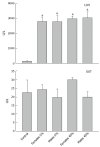Morphological and biochemical effects of weekend alcohol consumption in rats: Role of concentration and gender
- PMID: 29527265
- PMCID: PMC5838448
- DOI: 10.4254/wjh.v10.i2.297
Morphological and biochemical effects of weekend alcohol consumption in rats: Role of concentration and gender
Abstract
Aim: To examine the association between weekend alcohol consumption and the biochemical and histological alterations at two different concentrations of alcohol in both genders in rats.
Methods: Wistar rats weighing 170-200 g were divided into groups as follows: (1) Control groups; and (2) weekend alcohol-consumption group: 2 d/weekly per 12 wk, at two different concentrations: (1) Group of males or females with a consumption of a solution of alcohol at 40%; and (2) group of males or females with a consumption of a solution of alcohol at 5%. At the end of the experiment, serum and liver samples were obtained. The following enzymes and metabolites were determined in serum: Alanine Aminotransferase (ALT), Aspartate Aminotransferase (AST), Lactate Dehydrogenase, and Gamma-Glutamyltransferase, and glucose, triglycerides, cholesterol, bilirubin, and albumin. Liver samples from each group were employed to analyze morphological abnormalities by light microscopy.
Results: In all of the weekend alcohol-consumption groups, AST activity presented a significant, 10-fold rise. Regarding ALT activity, the groups with weekend alcohol consumption presented a significant increase that was six times greater. Bilirubin levels increased significantly in both groups of females. We observed a significant increase in the parameters of fatty change and inflammation due to weekend alcohol consumption. Only the group of females that consumed alcohol at 40% presented slight hepatocellular disorganization.
Conclusion: The results obtained herein provide solid evidence that weekend alcohol consumption gives rise to liver damage, demonstrated by biochemical and histological alterations, first manifested acutely, and prolonged weekend alcohol consumption can cause greater, irreversible damage.
Keywords: Damage; Liver morphology; Transaminases; Weekend alcohol consumption.
Conflict of interest statement
Conflict-of-interest statement: The authors declare no conflicts of interest.
Figures






Similar articles
-
NTP Toxicology and Carcinogenesis Studies of 4,4'-Thiobis(6- t -butyl- m -cresol) (CAS No. 96-69-5) in F344/N Rats and B6C3F1 Mice (Feed Studies).Natl Toxicol Program Tech Rep Ser. 1994 Dec;435:1-288. Natl Toxicol Program Tech Rep Ser. 1994. PMID: 12595928
-
NTP Toxicology and Carcinogenesis Studies of Pyridine (CAS No. 110-86-1) in F344/N Rats, Wistar Rats, and B6C3F1 Mice (Drinking Water Studies).Natl Toxicol Program Tech Rep Ser. 2000 Mar;470:1-330. Natl Toxicol Program Tech Rep Ser. 2000. PMID: 12579203
-
NTP Toxicology and Carcinogenesis Studies of Coumarin (CAS No. 91-64-5) in F344/N Rats and B6C3F1 Mice (Gavage Studies).Natl Toxicol Program Tech Rep Ser. 1993 Sep;422:1-340. Natl Toxicol Program Tech Rep Ser. 1993. PMID: 12616289
-
NTP Toxicology and Carcinogenesis Studies of C.I. Direct Blue 218 (CAS No. 28407-37-6) in F344/N Rats and B6C3F1 Mice (Feed Studies).Natl Toxicol Program Tech Rep Ser. 1994 Feb;430:1-280. Natl Toxicol Program Tech Rep Ser. 1994. PMID: 12616301
-
AST to ALT ratio and arterial stiffness in non-fatty liver Japanese population:a secondary analysis based on a cross-sectional study.Lipids Health Dis. 2018 Dec 3;17(1):275. doi: 10.1186/s12944-018-0920-4. Lipids Health Dis. 2018. PMID: 30509277 Free PMC article. Review.
Cited by
-
Lieber-DeCarli Diet Promotes Different Hepatic Histological Changes During Early and Late Pregnancy: An Example of Maternal Resilience.In Vivo. 2022 Sep-Oct;36(5):2232-2242. doi: 10.21873/invivo.12950. In Vivo. 2022. PMID: 36099127 Free PMC article.
-
Neonatal Orally Administered Zingerone Attenuates Alcohol-Induced Fatty Liver Disease in Experimental Rat Models.Metabolites. 2023 Jan 23;13(2):167. doi: 10.3390/metabo13020167. Metabolites. 2023. PMID: 36837786 Free PMC article.
References
-
- Morales González JA. Alcohol, Alcoholismo y Cirrosis. Un Enfoque Multidisciplinario. Pachuca: Universidad Autónoma del Estado de Hidalgo; 2007. p. 240.
-
- Piña Garza E, Gutiérrez Salinas J, Morales González JA, Zentella de Piña M. ¿Es tóxico el alcohol? In: Riveros Rosas H, Flores Herrera O, Sosa Peinado A, Vázquez Contreras E., editors. Temas Bioquímicos de vanguardia. México: Facultad de Medicina UNAM; 2003. pp. 121–146.
-
- Encuesta Nacional de Consumo de Drogas, Alcohol y Tabaco (ENCODAT) Consumo de alcohol: prevalencias globales, patrones de consumo y variaciones estatales. Comisión Nacional contra las Adicciones, México. Available from: https://www.gob.mx/cms/uploads/attachment/file/246052/hojasresumen_Alcoh....
-
- Berrios X, Jadue L, Pantoja T, Poblete JA, Moraga V, Pierotic M. [Alcohol consumption in the adult population from the metropolitan region: prevalence and consumption modalities] Rev Med Chil. 1991;119:833–840. - PubMed
-
- García-Moreno LM, Expósito J, Sanhueza C, Angulo MT. [Prefrontal activity and weekend alcoholism in the young] Adicciones. 2008;20:271–279. - PubMed
LinkOut - more resources
Full Text Sources
Other Literature Sources

